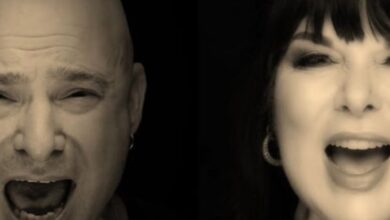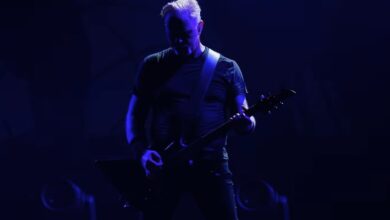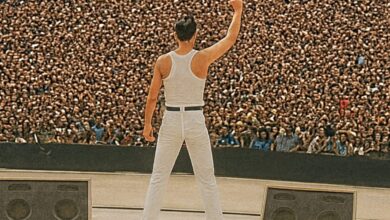Erik Grönwall’s “O Holy Night”: A Powerful Christmas Performance That Turned Faith, Survival, and Rock Passion Into Pure Magic
The surprise landed like a Christmas comet: Erik Grönwall, the powerhouse Swedish rock vocalist known for winning Idol in 2009, fronting H.E.A.T, and later joining Skid Row, unveiled a reverent and emotionally charged performance of “O Holy Night.” Filmed inside a candlelit church, the release was no ordinary holiday cover—it was an intimate, cinematic declaration of gratitude and triumph. For an artist whose career has thrived on voltage and velocity, this was intensity of a gentler kind, radiating faith, warmth, and quiet power in every note.
Although many listeners discovered it in December 2024, careful followers saw the buildup coming. A teaser hinted that the premiere would arrive on Friday, December 13 at 5 p.m. CET, shot with the blessing of Alunda Församling, the parish that offered its sanctuary. The location choice instantly elevated expectations: no studio tricks, no artificial echo, just real acoustics wrapping around a timeless hymn. When the video dropped, viewers were greeted with flickering candles and Grönwall’s voice rising like a beacon in winter darkness.
The performance unfolds with precision and restraint. He begins almost whisper-quiet, breathing the first verse rather than belting it, allowing the lyric’s sacred awe to sink in. Gradually, the sound expands—each modulation building emotional tension until the final chorus explodes in radiant strength. The singer’s control is impeccable: even the towering high notes sound effortless, supported rather than forced. It’s the sort of technical mastery that only years of rock touring could forge, now redirected toward reverence instead of rebellion.
Context makes the moment even more profound. In 2021 Grönwall was diagnosed with leukemia, underwent a bone marrow transplant, and fought his way back to full health. His story became a symbol of resilience across the rock world. After joining Skid Row in 2022 and stepping down two years later to focus on well-being, he turned his energy toward personal projects. “O Holy Night” arrived not just as a musical statement but as a celebration of survival—a hymn sung by someone who knows the meaning of deliverance firsthand.
The video’s visual language mirrors that transformation. There are no flashy effects, only soft candlelight, rustic wood, and stone walls catching the glow. The cinematography trusts the voice; shots linger instead of cutting rapidly, allowing emotion to bloom naturally. The camera keeps its distance until the climactic note, when it moves closer, capturing the tremor of breath and the satisfaction in Grönwall’s eyes. The production’s minimalism feels deliberate—proof that sincerity can outshine spectacle when the voice carries the truth.
Soon after release, views began climbing faster than a sleigh on rocket fuel. Within days, the clip surged past hundreds of thousands of streams and started drawing thousands of new subscribers to his channel. What made it spread wasn’t just Christmas timing; it was word of mouth. People who normally shared guitar solos were suddenly sharing a carol. The singer later posted that the video had surpassed 100 000 views per day and that he was preparing to release the track on all streaming services for those who wanted it beyond YouTube.
The magic lies in how the performance balances strength and serenity. Grönwall’s rock instincts give the hymn muscle, yet he never overwhelms the message. The arrangement breathes, leaving space between phrases, trusting silence as much as sound. When he finally unleashes his full range, it’s not a display of ego—it’s an act of devotion. That dynamic architecture turns a familiar carol into a cinematic journey: hushed prayer, gradual awakening, radiant finale.
Fan reactions reflected the depth of that transformation. Vocal coaches analyzed his phrasing and breath control, praising how he sustained upper-register notes without tension. Rock fans admired the power and grit, while faith listeners applauded the reverence. Across comment sections, the most common phrase was “goosebumps.” For once, an internet audience agreed on something: this wasn’t just a cover; it was an experience that transcended genre lines.
The church setting amplifies the spiritual realism. Unlike most Christmas performances filmed on sets, this one inhabits a living sacred space. The natural reverb of the sanctuary enriches every vowel and consonant, producing the same glow you hear in cathedral recordings from classic choirs. When the final note fades, you can feel the air settle. The sound isn’t digitally polished; it’s organic, like breathing inside a prayer.
Biographically, the song marks a closing loop. Before fame, Grönwall sang in choirs and local bands; success pulled him toward arenas, distortion, and decibels. After illness and recovery, he returned to something quieter but infinitely stronger: pure vocal storytelling. In that sense, “O Holy Night” bridges his past and present—the prodigy rediscovering humility through sound. Fans who followed his Skid Row chapter recognized that this wasn’t a departure from rock; it was rock energy reborn as worship.
Technically, the performance is a masterclass in control. The singer shapes vowels to expand resonance—“night” becomes an open tunnel of tone—and uses diaphragmatic support rather than throat pressure for sustain. These subtle details let him deliver the big climax with clarity and ring instead of strain. It’s the sonic equivalent of watching a tightrope walker glide across a cathedral arch: risk, grace, and poise perfectly balanced.
Each visual cue adds intimacy. A brief smile before the final verse, a glance upward as if to thank someone unseen, the soft exhale after the closing chord—small gestures that carry emotional weight. Nothing feels staged. Instead, the performance unfolds like a documentary of gratitude, a man fully present in the sound he’s making. In an era of filters and digital gloss, that authenticity hits harder than any pyrotechnic display ever could.
Strategically, releasing it mid-December created immediate impact, while later distributing it to streaming services guaranteed longevity. The move transformed a viral clip into a recurring tradition; every Christmas season, the track reappears in playlists and recommendations, carrying the same glow it had on day one. Grönwall himself noted that fans kept requesting the audio version—a sign that the song had already entered the canon of modern holiday classics.
For Scandinavian audiences, the choice carried cultural resonance. Known locally as “O Helga Natt,” the hymn is a staple of Nordic Christmas concerts, and delivering it in Swedish tradition’s natural setting—an old church, surrounded by light and stillness—added authenticity. Yet Grönwall’s English rendition reached far beyond Sweden, introducing international fans to that serene Northern Advent atmosphere. The performance became a bridge between worlds: Nordic calm meeting rock conviction.
Ultimately, the magic of “O Holy Night” lies not only in its sound but in what it represents. It’s the story of a singer who faced mortality and returned with greater purpose. It’s proof that rock power can coexist with sacred peace, and that a single voice in a quiet church can command as much force as a full arena. When Erik Grönwall hits the final “divine,” you hear both triumph and tenderness—a man grateful simply to sing.
Each December it resurfaces, carried by algorithms and affection alike. New listeners stumble upon it and end up staying through the whole thing, watching in silence. Longtime followers revisit it like lighting a candle. The song, once a hymn, becomes a ritual of resilience. Erik Grönwall didn’t just perform “O Holy Night”; he transformed it into a personal prayer that millions could share—a moment of light strong enough to last all year.
Grönwall’s remarkable versatility didn’t end with “O Holy Night.” Earlier, he stunned fans with a soaring, emotional take on Mariah Carey’s “Without You,” transforming the pop ballad into a rock powerhouse filled with raw vulnerability and vocal precision. His ability to fuse tenderness with intensity gave the song a whole new dimension, proving once again that he could channel deep emotion through sheer power without losing its delicate heart.
He later took on Whitney Houston’s timeless “I Will Always Love You,” delivering a rendition that balanced technical brilliance with genuine soul. Stripping away the pop gloss, Grönwall infused the song with a rock edge that highlighted his vocal range and control while keeping its message of love and farewell intact. Together, these performances stand as proof that his voice transcends genre — capable of evoking goosebumps, reverence, and pure awe in equal measure.





